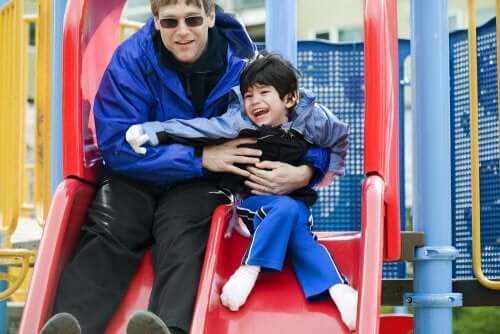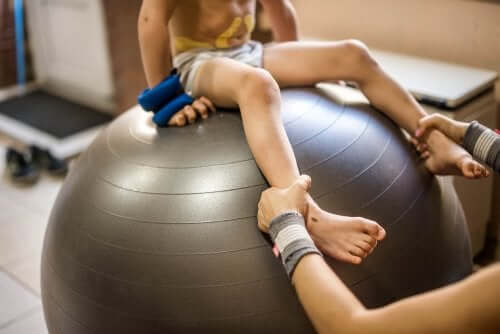Cerebral Palsy: What You Should Know

Cerebral palsy affects lots of kids. Having a child with this condition can be very hard for many parents. This is especially true at first, since they have to get used to the situation. However, as good citizens, we should all know about this issue. That way, we can help understand these children and their families.
What is cerebral palsy?
Childhood cerebral palsy is a movement, muscle tone or posture disorder. It also involves persistent motor issues. It happens because of a non-progressive brain injury that interferes with brain development. In general, these are its characteristics:
- Non-progressive brain injury that interferes with the central nervous system.
- Appearance of a motor disorder before age three.
- Persistence of symptoms throughout life.
- Presence of other associated disorders. For example, there might be language, sensory, cognitive, perceptual and personality disorders. In addition, there might be epileptic seizures.
Therefore, these kids have problems with psychomotor development. For example, they have trouble with posture, walking, and manipulating things. They tend to keep the primary reflexes, which appear at birth and usually go away as children grow. In addition, they don’t get secondary reflexes. Usually, these appear in the first few months of life.

On the other hand, cerebral palsy can affect muscle tone. These can be:
- Isotonic: normal tone.
- Hypertonic: increased tone.
- Hypotonic: decreased tone.
- Dystonic: inconsistent tone between hypotonic and hypertonic.
In addition, the digestive, respiratory and postural problems can also make it hard for kids with cerebral palsy to eat. They also have other issues with their mouth, like excessive salivation, hypersensitivity, and more.
For all these reasons, children with cerebral palsy are all very different. They can have different symptoms and different severity. It all depends on the area of the brain with the lesion.
What are the causes of childhood cerebral palsy?
Some of the most common causes of cerebral palsy are:
- Prenatal: When the brain injury happens during pregnancy. Therefore, before the fourth month of pregnancy, it’s considered an embryopathy. However, if it happens after the fourth month, it’s a fetopathy.
- Perinatal: When the injury happens at the time of birth. This can happen from not having enough oxygen. Also, it could be from trauma or complications at birth.
- Postnatal: When the injury occurs after birth. This could be from infections, head trauma, metabolic diseases, vascular accidents, eating problems, etc.
Importance of intervention
To find and treat each child’s individual problems, it’s important to have detailed tests. You should have tests to make a diagnosis. Also, they have to be at the beginning and end of treatments. That way, you can see the changes that the treatments are making.
These evaluations need to be done by a multidisciplinary team. The people that do these evaluations are:
- Medical neonatologists
- Neurologists
- Pediatricians
- Physiotherapists
- Speech therapists
- Psychologists
- Teachers
- Occupational therapists
All of them must work as a team. That way, they can respond to the needs of the child with cerebral palsy.
Therefore, it’s important for interventions to focus on each individual child. They also need to use the tools and methods that best adapt to each child’s development.
In addition, kids with cerebral palsy need to work on stimulation. They can do this through basal stimulation programs, infant massages, multi-sensory stimulation rooms, etc.

It’s also important to start treatment as soon as possible. That way, kids can start going to programs as soon as possible. They can get a better prognosis and developmental support.
In conclusion
Finally, we should mention that childhood cerebral palsy has no cure. However, it’s possible to equip kids with certain skills so they can adapt to society.
Society must also adapt. That way, they become aware of the problem. Also, they make sure that the environment is accessible. Nothing should stop these children from enjoying a dignified and inclusive life.
Ultimately, we must strive to develop a sense of community and mutual support based on social justice and solidarity. As Dr. Yadiar Julián states:
“It is not disability that makes life difficult for these people, but the thoughts and actions of others.”
– Yadiar Julián –
Cerebral palsy affects lots of kids. Having a child with this condition can be very hard for many parents. This is especially true at first, since they have to get used to the situation. However, as good citizens, we should all know about this issue. That way, we can help understand these children and their families.
What is cerebral palsy?
Childhood cerebral palsy is a movement, muscle tone or posture disorder. It also involves persistent motor issues. It happens because of a non-progressive brain injury that interferes with brain development. In general, these are its characteristics:
- Non-progressive brain injury that interferes with the central nervous system.
- Appearance of a motor disorder before age three.
- Persistence of symptoms throughout life.
- Presence of other associated disorders. For example, there might be language, sensory, cognitive, perceptual and personality disorders. In addition, there might be epileptic seizures.
Therefore, these kids have problems with psychomotor development. For example, they have trouble with posture, walking, and manipulating things. They tend to keep the primary reflexes, which appear at birth and usually go away as children grow. In addition, they don’t get secondary reflexes. Usually, these appear in the first few months of life.

On the other hand, cerebral palsy can affect muscle tone. These can be:
- Isotonic: normal tone.
- Hypertonic: increased tone.
- Hypotonic: decreased tone.
- Dystonic: inconsistent tone between hypotonic and hypertonic.
In addition, the digestive, respiratory and postural problems can also make it hard for kids with cerebral palsy to eat. They also have other issues with their mouth, like excessive salivation, hypersensitivity, and more.
For all these reasons, children with cerebral palsy are all very different. They can have different symptoms and different severity. It all depends on the area of the brain with the lesion.
What are the causes of childhood cerebral palsy?
Some of the most common causes of cerebral palsy are:
- Prenatal: When the brain injury happens during pregnancy. Therefore, before the fourth month of pregnancy, it’s considered an embryopathy. However, if it happens after the fourth month, it’s a fetopathy.
- Perinatal: When the injury happens at the time of birth. This can happen from not having enough oxygen. Also, it could be from trauma or complications at birth.
- Postnatal: When the injury occurs after birth. This could be from infections, head trauma, metabolic diseases, vascular accidents, eating problems, etc.
Importance of intervention
To find and treat each child’s individual problems, it’s important to have detailed tests. You should have tests to make a diagnosis. Also, they have to be at the beginning and end of treatments. That way, you can see the changes that the treatments are making.
These evaluations need to be done by a multidisciplinary team. The people that do these evaluations are:
- Medical neonatologists
- Neurologists
- Pediatricians
- Physiotherapists
- Speech therapists
- Psychologists
- Teachers
- Occupational therapists
All of them must work as a team. That way, they can respond to the needs of the child with cerebral palsy.
Therefore, it’s important for interventions to focus on each individual child. They also need to use the tools and methods that best adapt to each child’s development.
In addition, kids with cerebral palsy need to work on stimulation. They can do this through basal stimulation programs, infant massages, multi-sensory stimulation rooms, etc.

It’s also important to start treatment as soon as possible. That way, kids can start going to programs as soon as possible. They can get a better prognosis and developmental support.
In conclusion
Finally, we should mention that childhood cerebral palsy has no cure. However, it’s possible to equip kids with certain skills so they can adapt to society.
Society must also adapt. That way, they become aware of the problem. Also, they make sure that the environment is accessible. Nothing should stop these children from enjoying a dignified and inclusive life.
Ultimately, we must strive to develop a sense of community and mutual support based on social justice and solidarity. As Dr. Yadiar Julián states:
“It is not disability that makes life difficult for these people, but the thoughts and actions of others.”
– Yadiar Julián –
All cited sources were thoroughly reviewed by our team to ensure their quality, reliability, currency, and validity. The bibliography of this article was considered reliable and of academic or scientific accuracy.
- Basil, C. (2012). Los alumnos con parálisis cerebral y otras alteraciones motrices. En Á. Marchesi, J. P. González y C. Coll (Ed.), Desarrollo Psicológico Y Educación: 3. Trastornos Del Desarrollo Y Necesidades Educativas Especiales (pp. 303-328). Madrid: Alianza Editorial.
- Little Club. (1959). Mac Keith, R.C., MacKcnzie, I.C.K. y Polani, P.E. (Eds.). Memorandum on terminology and classification of “cerebral palsy”. Cerebal Palsy Bull, 1, 27-35.
- Muñoz, A. M. (2007). La parálisis cerebral. Observatorio de la discapacidad. Instituto de Mayores y Servicios Sociales (IMSERSO).
This text is provided for informational purposes only and does not replace consultation with a professional. If in doubt, consult your specialist.








